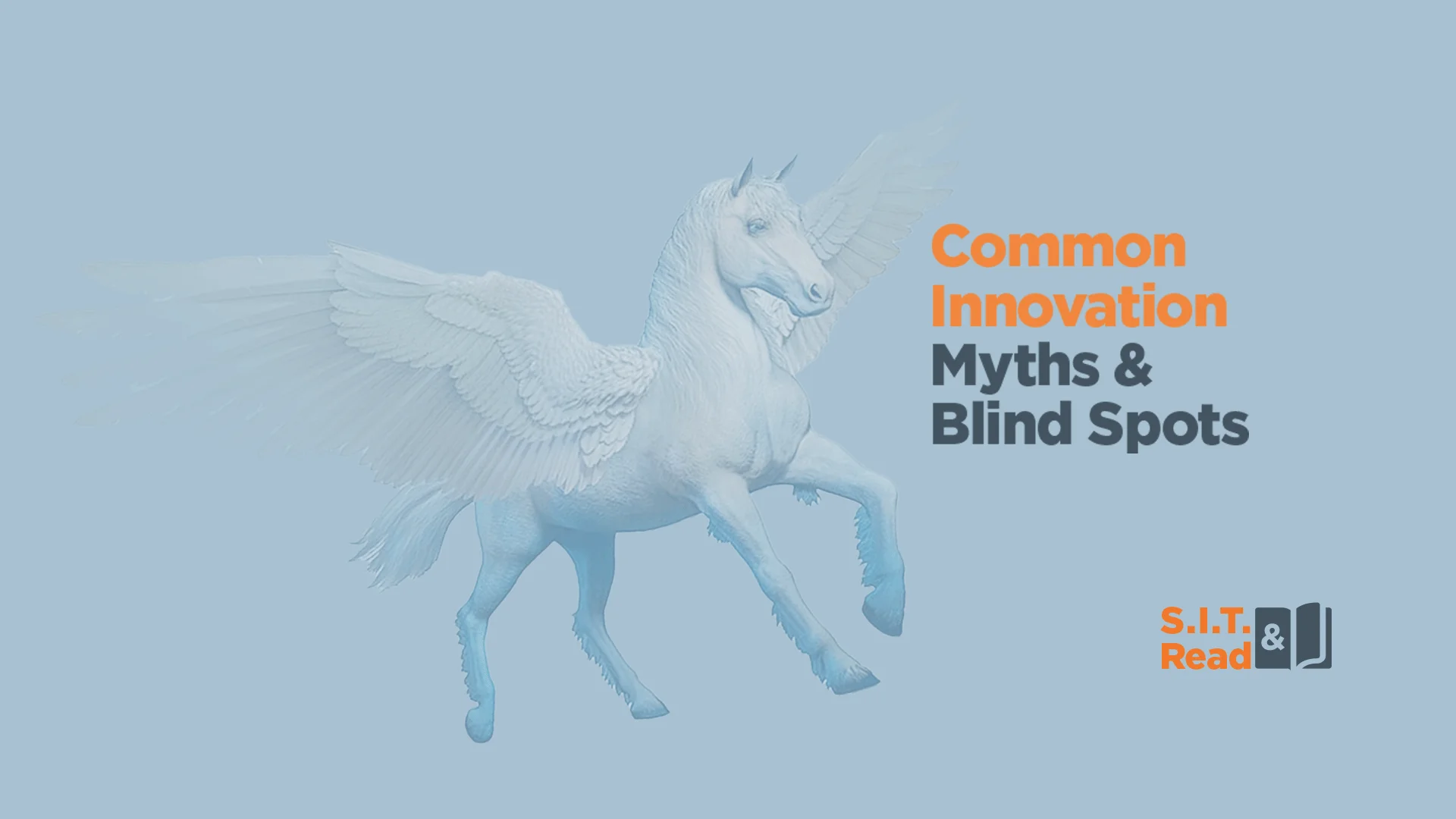Common Innovation Myths & Blind Spots


Innovation is a nascent discipline and, as such, very few of its “truths” and tenets have had the opportunity to mature and to brave the test of time. Less diplomatically, one can say that much of what is said about innovation is not worth the flip-chart paper it is written on. Strangely enough, even though the topic is so new, some common views have already attained the status of myths, which makes it a bit difficult to unseat them and thus avoid some of the damage that these beliefs cause in organizations.
Becoming aware of their existence and their effect is an important first step in ridding oneself of their effect. For each of the 7 Elements, we share one related myth that needs to be busted. (Link to the 7 Elements’ article below).
SKILLS
Myth #1: Artists are creative. Engineers, accountants and bureaucrats are not.
Alternative: Look around you – most innovations you will see were invented and designed by engineers.
It is commonly assumed that some of us have the innovation gift while others simply don’t, rendering them incapable of innovating. This is incorrect and, in addition to academic research, we have 26 years of experience in the field to prove it. The truth is that skills and processes that lead to innovation can be taught. Everyone can significantly improve their skills, regardless of their baseline.
GOVERNANCE
Myth #2: Innovation cannot be measured
Alternative: ROI – Return on Innovation, absolutely must be measured, otherwise no serious innovation effort will be sustained in the organization.
To many, innovation is amorphous and mysterious and thus can be difficult to measure and monitor. There is even a fear that measurement itself can stifle innovation. This is true, but only if the wrong indicators are used at the wrong time. That’s why it’s important to clearly define what the organization means by innovation. Once there is a clear definition, it is possible and crucial to measure your ROI, although the way to do it is not always intuitive.
OUTCOMES
Myth #3: Innovation is mostly about creating products or services.
Alternative: Innovation can and should be applied to every aspect of your business.
We advocate an innovation mindset, not merely to create new products and services, but to “innovate in what you do”. If applied in a structured way, using appropriate tools, any task or process can be innovated on, to achieve your goals. Apply the right innovation tools to your productivity efforts, your digital transformation initiatives, and supply chain challenges to improve results.
RESOURCES
Myth #4: Top Management’s only job is to launch the innovation program and budget it.
Alternative: Without ongoing management commitment, the effort cannot be sustained.
Top Management very often makes a brave decision to launch an ambitious, company-wide innovation effort, and even budgets it generously. But, very quickly, responsibility is relegated to lower ranks in the corporate hierarchy, and executives impatiently adopt the role of demanding quick tangible results. Instead of supporting the effort for the long haul, management becomes impatient to either celebrate prematurely or move on to the next “management-flavor-of-the-month”.
PROCESSES
Myth #5: Brainstorming is the best way to come up with new ideas.
Alternative: It has been proven time and again that BS is not effective in generating truly novel ideas.
Brainstorming has many advantages but, as research and corporate experiences have shown time and again, creating novelty is not one of them. By placing constraints on your thinking and using a structured approach, you can consistently achieve success.
BEHAVIORS
Myth #6: Innovation and creativity are always fun.
Alternative: Dabbling in innovation, as enrichment or mental exercises can be lots of fun, but true innovation, in the sense of challenging your deep assumptions and firmly set ways of working, mostly involves hard work and requires discipline. There is much in the process that one can enjoy, but true change of beliefs and habits cannot be all fun and games. That is why very often a facilitated team effort with clear deliverables is required to achieve impactful innovation.
COMMUNICATION
Myth #7: Those who oppose innovation programs are wrong. They are simply “resisting”.
Alternative: Very often, those who “resist innovation” have an important point to make.
Resistance to innovation often emerges from the “wrong” motivations: fear of change, turf wars, oversized egos, etc. But, this opposition doesn’t always need to be “overcome”, rather, it is often very useful to listen carefully since those who oppose change often do so for valid and solid reasons that need to be dealt with if the results are to see the light of day. Resistance can also be a sign of the strong potential for novelty, pointing at valuable dig-sites.
These are only several of the common myths and traps that organizations deal with and fall into when embarking on innovation journeys. Talk to us, and we’ll be happy to hear/read your thoughts, and also to acknowledge – when relevant – that we ourselves are as vulnerable as anyone else to being wrong(:
What are some myths that you’ve been trying to bust in your organization?
Recent Posts
Innovation Behavior
Innovation is a skill, not a gift. Top organizations drive growth by nurturing and investing…
Should you learn TRIZ? – Yes. ….and No.
Are you in the world of problem solving? Is problem solving a skillset you have…
What Lies Ahead in 2024?
5 Data-Driven, Customer-Centric trends we’ve identified This is not just another conventional forecast. Over nearly…
Fork or Chopsticks – Which Innovation Tools Do You Use?
Imagine a chef, who only uses a spoon. Imagine a dentist, who only uses a…
The Moat Mentality: Exploring New Frontiers in Innovation Methodologies
In investing and business strategy, we often speak in terms of moats. Warren Edward Buffett…
Was it a Breakthrough or an Adjacency?
This year, P&G’s Febreze celebrates its silver anniversary as a brand. But not all 25…


